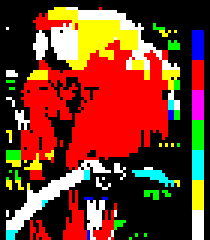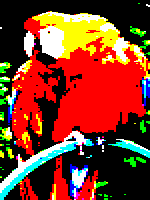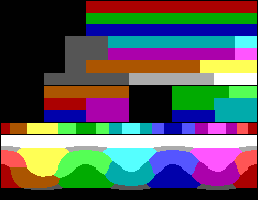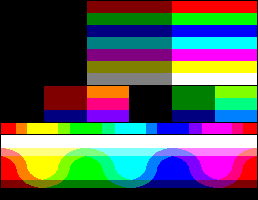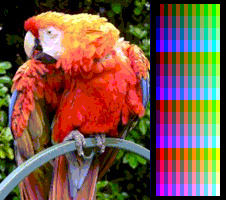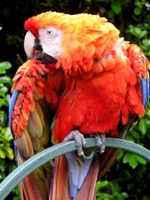List of 8-bit computer hardware graphics
hideThis article has multiple issues. Please help or discuss these issues on the talk page. (Learn how and when to remove these template messages)
|
This is a list of notable 8-bit computer color palettes, and graphics, which were primarily manufactured from 1975 to 1985. Although some of them use RGB palettes, more commonly they have 4, 16 or more color palettes that are not bit nor level combinations of RGB primaries, but fixed ROM/circuitry colors selected by the manufacturer. Due to mixed-bit architectures, the n-bit distinction is not always a strict categorization. Another common mistake is the assumption that a color palette of a given computer is what it can display all at once. Resolution is also a crucial aspect when criticizing an 8-bit computer, as many offer different modes with different amounts of colors on screen, and different resolutions, with the intent of trading off resolution for color, and vice versa.
Sample image Color test chart 3-bit, 8-color palette 6-bit, 64-color palette 

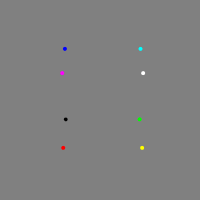
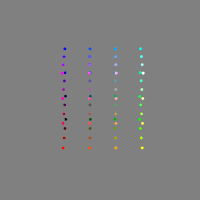
3-bit RGB palettes[]
Systems with a 3-bit RGB palette use 1 bit for each of the red, green and blue color components. That is, each component is either "on" or "off" with no intermediate states. This results in an 8-color palette ((21)3 == 23 == 8) that have black, white, the three RGB primary colors red, green and blue and their correspondent complementary colors cyan, magenta and yellow as follows:
Palette coverage Color indexes 

The color indices vary between implementations; therefore, index numbers are not given.
The 3-bit RGB palette is used by:
- The ECMA-48 standard for text terminals (sometimes known as the "ANSI standard", although ANSI X3.64 does not define colors)
- Teletext Level 1/1.5 Teletext.
- Videotex
- Oric
- BBC Micro
- The original NEC PC-8801 up to the MkII
- The original NEC PC-9801 with original 8086 CPU before the VM/VX models
- All Sharp X1 models before the X1 Turbo Z
- The Sharp MZ 700
- Fujitsu FM-7, FM New 7, FM 77 before the FM77AV
- Sinclair QL
- The Macintosh SE with a color printer or external monitor
- The SECAM version of the Atari 2600
- The Color Maximite, a PIC32 based microcomputer
Specific details about implementation and actual graphical capabilities of specific systems, are listed on the next sub-sections.
World System Teletext Level 1[]
World System Teletext Level 1 (1976) uses a 3-bit RGB, 8-color palette. Teletext has 40×25 characters per page of which the first row is reserved for a page header. Every character cell has a background color and a text color. These attributes along with others are set through control codes which each occupy one character position. Graphics characters consisting of 2×3 cells can used following a graphics color attribute. Up to a maximum of 72×69 blocky pixels can be used on a page.
Simulated image
BBC Micro[]
BBC Micro has 8 display modes, with resolutions like 640×256 (max. 2 colors), 320×256 (max. 4 colors) and 160×256 (max. 16 logical colors). No display modes have cell attribute clashes. The palette available has only 8 physical colors, plus a further 8 flashing colors (each being one of the eight non-flashing colors alternating with its physical complement every second), and the display modes can have 16, 4 or 2 simultaneous colors.
Simulated image
BBC Micro display modes
Mode 0 (640 × 256, 2 colors) Mode 1 (320 × 256, 4 colors) Mode 2 (160 × 256, 8 colors) 
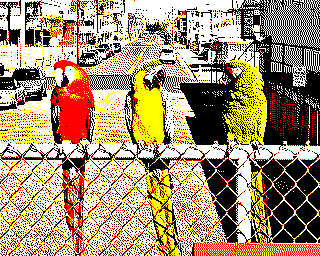
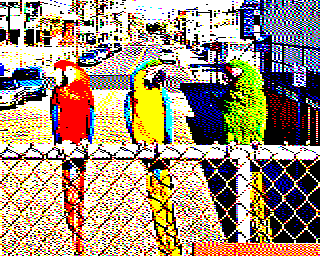
Mode 4 (320 × 256, 2 colors) Mode 5 (160 × 256, 4 colors) Mode 8 (80 × 256, 8 colors) 


Sinclair QL (Sinclair Quantum Leap)[]
This section needs expansion. You can help by . (March 2019) |
On the Sinclair QL two video modes were available, 256×256 pixels with 8 RGB colors and per-pixel flashing, or 512×256 pixels with four colors: black, red, green and white. The supported colors could be stippled in 2×2 blocks to simulate up to 256 colors, an effect which did not copy reliably on a TV, especially over an RF connection. Pixel aspect ratio was not square, with resulting image proportions close to 4.4:3, making the image extend into the horizontal overscan area of a CRT TV.
256x256 mode 512x256 mode 


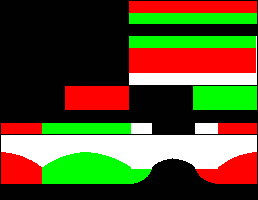
Simulated images (aspect ratio corrected) 

Simulated images (original pixel size) 

256×256 512×256 black black blue red red magenta green green cyan yellow white white
PC-8000 series[]
The NEC PC-8000 was capable of displaying graphics with a resolution of 160x100 pixels and 8 colors.
4-bit RGBI palettes[]
The 4-bit RGBI palette is similar to the 3-bit RGB palette but adds one bit for intensity. This allows each of the colors of the 3-bit palette to have a variant (on most machines dark or bright, but saturated or unsaturated was also possible) potentially giving a total of 23×2 == 16 colors. Some implementations had only 15 effective colors due to the "dark" and "bright" variations of black being displayed identically. Others generated a grey tone or a different color.
This 4-bit RGBI schema is used in several platforms with variations, so the table given below is a simple reference for the palette richness, and not an actual implemented palette. For this reason, no numbers are assigned to each color, and color order is arbitrary.
Systems that used this palette scheme:
- IBM's original Color Graphics Adapter
- IBM's Enhanced Graphics Adapter, in CGA modes
- Tandy graphics on IBM's PCjr and Tandy 1000-series computers
- Plantronics Colorplus on a limited number of PC-compatible computers
- MCGA and VGA graphics standards for backward compatibility
- Commodore 128 series for its 80-column mode
- ZX Spectrum (and compatible)
- CPC 464/664/6128
- series computers
- Thomson MO5 and TO7
Specific details about implementation and actual graphical capabilities of specific systems, are listed on the next sub-sections.
ZX Spectrum[]
The ZX Spectrum (and compatible) computers use a variation of the 4-bit RGBI palette philosophy. This results in each of the colors of the 3-bit palette to have a basic and bright variant, with the exception of black. This was accomplished by having a maximum voltage level for the bright variant, and a lower voltage level for the basic variant. Due to this, black is the same in both variants.
The attribute byte associated to every 8×8 pixel cell dedicates (from LSB to MSB): three bits for the background color; three bits for the foreground color; one bit for the bright variant for both, and one bit for the flashing effect (alternate foreground and background colors evenly in time). So the colors are not selectable as indices of a true palette (there are not color numbers 8 to 15).
The color numbers can be employed with the following statements to choose:
- BORDER n, the color for the surrounding area outside the pixel graphical area.
- PAPER n, the background (pixel bit value of 0) color for an 8×8 pixel cell.
- INK n, the foreground (pixel bit value of 1) color for an 8×8 pixel cell.
Simulated image Sample image and palette 



Color number Binary value BRIGHT 0 BRIGHT 1 0 000 black black 1 001 basic blue bright blue 2 010 basic red bright red 3 011 basic magenta bright magenta 4 100 basic green bright green 5 101 basic cyan bright cyan 6 110 basic yellow bright yellow 7 111 basic white bright white
IBM PC/XT and compatible systems[]
- For the palettes of more advanced original IBM AT, IBM PS/2 and better PC compatibles hardware displays, please visit IBM PC/AT and compatible systems in the List of 16-bit computer color palettes article.
The original IBM PC launched in 1981 features an Intel 8088 CPU which has 8-bit data bus technology, though internally the CPU has a fully 16-bit architecture. It was offered with a Monochrome Display Adapter (MDA) or a Color Graphics Adapter (CGA). The MDA is a text mode-only display adapter, without any graphic ability beyond using the built-in code page 437 character set (which includes half-block and line-drawing characters), and employed an original IBM green monochrome monitor; only black, green and intensified green could be seen on its screen.[citation needed] Then, only the CGA had true graphic modes.
The IBM PC XT model, which succeeded the original PC in 1983, has an identical architecture and CPU to its predecessor, only with more expansion slots and a hard disk equipped as standard. The same two video cards, the MDA and the CGA, remained available for the PC XT, and no upgraded video hardware was offered by IBM until the EGA, which followed the introduction of the IBM Personal Computer/AT, with its full 16-bit bus design, in 1984.
CGA[]
The Color Graphics Adapter (CGA) outputs what IBM called "digital RGB"[1] (that is, the R, G, B (and I) signals from the graphics card to the monitor can each only have two states: on or off). CGA supports a maximum of 16 colors. However, its 320×200 graphics mode is restricted to fixed palettes containing only four colors, and the 640×200 graphic mode is only two colors. 16 colors are only available in text mode or the "tweaked text" 160×100 mode. A different set of 16 colors is available in composite mode with an NTSC composite monitor. (Independent groups have also demonstrated much larger composite color sets—over 256 colors—on a composite monitor by the use of artifact color techniques. See Color Graphics Adapter#High color depth.)
The full standard RGBI palette is a variant of the 4-bit RGBI schema. Although the RGBI signals each have only two states, the CGA color monitor decodes them as if RGB signals had four levels. Darker colors are the basic RGB 2nd level signals except for brown, which is dark yellow with the level for the green component halved (1st level). Brighter colors are made by adding a uniform intensity one-level signal to every RGB signal of the dark ones, reaching the 3rd level (except dark gray which reaches only the 1st level), and in this case yellow is produced as if the brown were ordinary dark yellow.
0 — black 8 — dark gray 1 — low blue 9 — high blue 2 — low green 10 — high green 3 — low cyan 11 — high cyan 4 — low red 12 — high red 5 — low magenta 13 — high magenta 6 — brown 14 — yellow 7 — light gray 15 — white
The color numbers above are not arbitrary; they are based on the following bitmask:
Binary Decimal Color 1000 8 intense, high, or bright 0100 4 red 0010 2 green 0001 1 blue
*A few earlier non-IBM compatible CGA monitors lack the circuitry to decode color numbers as of four levels internally, and they cannot show brown and dark gray. The above palette is displayed in such monitors as follows:
0 — black 8 — black* 1 — low blue 9 — high blue 2 — low green 10 — high green 3 — low cyan 11 — high cyan 4 — low red 12 — high red 5 — low magenta 13 — high magenta 6 — low yellow* 14 — yellow 7 — light gray 15 — white
- 16-color palette modes
The only full 16-color BIOS modes of the CGA are the text mode 0 (40×25) and mode 2 (80×25). Disabling the flashing attribute effect and using the IBM 437 codepage block characters 220 (DCh) ▄ (bottom half) or 223 (DFh) ▀ (upper half), the mode 2 screen buffer provides an 80×50 quasi-graphic mode.
Also, a tweak mode can be set in the CGA to give an extra, non-standard 160×100 pixels 16-color graphic mode.
16-color, 80×50 mode 16-color, 160×100 mode 16-color comparison image 


- 4-color palette modes
In the 320×200 graphics mode, every pixel has two bits. A value of 0 is always a selectable background-plus-border color (with the same register and/or BIOS call used for the foreground color in the 640×200 graphic mode; black by default), and the three remaining values 1 to 3 are indices to one of the predefined color palette entries.
The selection of a palette is a bit complex. There are two BIOS 320×200 CGA graphics modes: modes 4 and 5. Mode 4 has the composite color burst output enabled (in the Mode Control Register at I/O address 3D8H, bit 2 is cleared), and mode 5 has it disabled (the same bit 2 is set). Mode 5 is intended mainly for a monochrome composite video monitor, but because of a specific intentional feature of the CGA hardware, it also has a different palette for an RGBI color monitor. For mode 4, two palettes can be chosen: green/red/brown and cyan/magenta/white; the difference is the absence or presence of the blue signal in all three colors. (The palette is selected with bit 5 of the Color-Select Register at I/O address 3D9h, where the bit value 1 selects the cyan/magenta/white palette [a/k/a "palette #1" because it is the BIOS default] and 0 selects the green/red/brown palette [a/k/a "palette #2"]. This bit can be set using BIOS INT 10h function 0Bh, subfunction 1.) The palette for BIOS video mode 5 is always cyan/red/white: blue is always on, and red and green each are controlled directly by one of the two bits of the pixel color value. For each of these three palette options, a low or high intensity palette can be chosen with bit 4 of the aforementioned Color-Select Register: a value of 0 means low intensity and 1 means high intensity. (No BIOS call exists to switch between the two intensity modes.) The selected intensity setting simply controls the "I" output signal to the RGBI monitor for all colors in the palette. As a result, the green-red-brown palette appears as bright-green/bright-red/yellow when high intensity is selected. The combination of color-burst enable/disable selection, palette selection, and intensity selection yields a total of 6 different possible palettes for CGA 320×200 graphics.

- Mode 4, palette #1, low intensity:
0 — [user-defined] 1 — cyan 2 — magenta 3 — light grey
- The sixteen combinations with the background color are:
0 1 _ 0 1 _ 0 1 _ 0 1 * 0 1 _ 0 1 * 0 1 _ 0 1 * 2 3 _ 2 3 _ 2 3 _ 2 3 _ 2 3 _ 2 3 _ 2 3 _ 2 3 _
0 1 _ 0 1 _ 0 1 _ 0 1 _ 0 1 _ 0 1 _ 0 1 _ 0 1 _ 2 3 _ 2 3 _ 2 3 _ 2 3 _ 2 3 _ 2 3 _ 2 3 _ 2 3 _
- (*) Useless due to the duplication of one of the colors.


- Mode 4, palette #1, high intensity:
0 — [user-defined] 1 — bright cyan 2 — bright magenta 3 — bright white
- The sixteen combinations with the background color are:
0 1 _ 0 1 _ 0 1 _ 0 1 _ 0 1 _ 0 1 _ 0 1 _ 0 1 _ 2 3 _ 2 3 _ 2 3 _ 2 3 _ 2 3 _ 2 3 _ 2 3 _ 2 3 _
0 1 _ 0 1 _ 0 1 _ 0 1 * 0 1 _ 0 1 * 0 1 _ 0 1 * 2 3 _ 2 3 _ 2 3 _ 2 3 _ 2 3 _ 2 3 _ 2 3 _ 2 3 _
- (*) Useless due to the duplication of one of the colors.

- Mode 4, palette #2, low intensity:
0 — [user-defined] 1 — green 2 — red 3 — brown
- The sixteen combinations with the background color are:
0 1 _ 0 1 _ 0 1 * 0 1 _ 0 1 * 0 1 _ 0 1 * 0 1 _ 2 3 _ 2 3 _ 2 3 _ 2 3 _ 2 3 _ 2 3 _ 2 3 _ 2 3 _
0 1 _ 0 1 _ 0 1 _ 0 1 _ 0 1 _ 0 1 _ 0 1 _ 0 1 _ 2 3 _ 2 3 _ 2 3 _ 2 3 _ 2 3 _ 2 3 _ 2 3 _ 2 3 _
- (*) Useless due to the duplication of one of the colors.
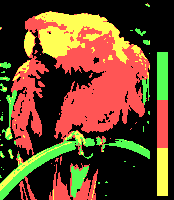

- Mode 4, palette #2, high intensity:
0 — [user-defined] 1 — bright green 2 — bright red 3 — yellow
- The sixteen combinations with the background color are:
0 1 _ 0 1 _ 0 1 _ 0 1 _ 0 1 _ 0 1 _ 0 1 _ 0 1 _ 2 3 _ 2 3 _ 2 3 _ 2 3 _ 2 3 _ 2 3 _ 2 3 _ 2 3 _
0 1 _ 0 1 _ 0 1 * 0 1 _ 0 1 * 0 1 _ 0 1 * 0 1 _ 2 3 _ 2 3 _ 2 3 _ 2 3 _ 2 3 _ 2 3 _ 2 3 _ 2 3 _
- (*) Useless due to the duplication of one of the colors.

- Mode 5, low intensity:
0 — [user-defined] 1 — cyan 2 — red 3 — light grey
- The sixteen combinations with the background color are:
0 1 _ 0 1 _ 0 1 _ 0 1 * 0 1 * 0 1 _ 0 1 _ 0 1 * 2 3 _ 2 3 _ 2 3 _ 2 3 _ 2 3 _ 2 3 _ 2 3 _ 2 3 _
0 1 _ 0 1 _ 0 1 _ 0 1 _ 0 1 _ 0 1 _ 0 1 _ 0 1 _ 2 3 _ 2 3 _ 2 3 _ 2 3 _ 2 3 _ 2 3 _ 2 3 _ 2 3 _
- (*) Useless due to the duplication of one of the colors.


- Mode 5, high intensity:
0 — [user-defined] 1 — bright cyan 2 — bright red 3 — white
- The sixteen combinations with the background color are:
0 1 _ 0 1 _ 0 1 _ 0 1 _ 0 1 _ 0 1 _ 0 1 _ 0 1 _ 2 3 _ 2 3 _ 2 3 _ 2 3 _ 2 3 _ 2 3 _ 2 3 _ 2 3 _
0 1 _ 0 1 _ 0 1 _ 0 1 * 0 1 * 0 1 _ 0 1 _ 0 1 * 2 3 _ 2 3 _ 2 3 _ 2 3 _ 2 3 _ 2 3 _ 2 3 _ 2 3 _
- (*) Useless due to the duplication of one of the colors.
- When viewed in a monochrome composite monitor, the mode 5 palettes above are shown as a (more or less brighter) 2-bit grayscale palette:
- 2-color palette mode
In the 640×200 graphic mode (BIOS mode number 6), every pixel has only a single bit. The foreground color can be set, with the default being white.
2-color 2-color comparison image 

0 — black 1 — [user-defined]
- The sixteen combinations are:
0 1 _ 0 1 _ 0 1 _ 0 1 _ 0 1 _ 0 1 _ 0 1 _ 0 1 _
0 1 _ 0 1 _ 0 1 _ 0 1 _ 0 1 _ 0 1 _ 0 1 _ 0 1 _
PCjr and Tandy 1000 series[]
The IBM PCjr features a "CGA Plus" video subsystem, consisting mainly of a 6845 CRTC and an LSI video chip known as the "Video Gate Array", that can show all 16 CGA colors simultaneously on screen in the extended low-res graphic modes. The near-compatible Tandy 1000 series features almost 100% PCjr-compatible video hardware implemented in a Tandy proprietary chip. This graphics adapter is better known by the name Tandy Graphics Adapter, because the PCjr was short-lived but the Tandy 1000 line was quite popular for many years. The video mode capabilities of early-model Tandy 1000 computers are exactly the same as the PCjr's. (Later Tandy 1000 models featured "Tandy Video II" hardware which added a 640x200 16-color mode but surrendered PCjr hardware register-compatibility for CGA register-compatibility.)
The PCjr adds three video modes to the CGA mode set: 160×200 16-color "low-resolution" graphics, 320×200 16-color "medium-resolution" graphics, and 640×200 4-color "high-resolution" graphics. All PCjr/Tandy 1000 graphics modes can reassign any color index to any palette entry, allowing free selection of all palette colors in modes with fewer than 16 colors (including the plain CGA modes) and enabling color cycling effects in all modes. The PCjr also offers a graphics blink function which causes 8 colors to alternate between the low and high halves of the 16-color palette at the text blink rate. (A PCjr must be upgraded with a PCjr-specific internal 64 KB memory expansion card in order to use the latter two of these modes or any 80-column text mode. Tandy 1000 base models can use all video modes.)
| 0 | 1 | 2 | 3 | 4 | 5 | 6 | 7 |
| 8 | 9 | 10 | 11 | 12 | 13 | 14 | 15 |
Thomson[]
For Thomson computers, a popular brand in France, the most common display modes are 320×200, with 8×1 attribute cells with 2 colors. Here the intensity byte affects saturation and not only brightness variations.
Thomson MO5 and TO7[]
The Thomson MO5 generated graphics based on a EFGJ03L gate array.[2] The palette was based on 8 RGB primary colors, with an intensity bit that could change its brightness or saturation.[3] This allowed the machine to generate a 320×200 16 color display, but subject to proximity constraints (only two colors for a 8x1 pixel area). The Thomson TO7 had similar graphic abilities and palette.[4]
| 0 | 1 | 2 | 3 | 4 | 5 | 6 | 7 |
| 8 | 9 | 10 | 11 | 12 | 13 | 14 | 15 |
Simulated image Color test chart 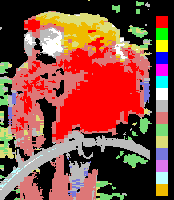
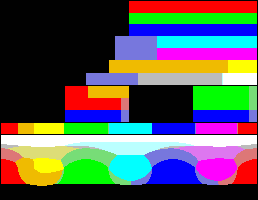
Thomson TO7/70[]
The Thomson TO7/70 used a Motorola MCA1300 gate array and provided fixed 16 color palettes, as shown below.
Fixed color palette 1
Sample image Color test chart 

0x0 0x1 0x2 0x3 0x4 0x5 0x6 0x7 0x8 0x9 0xA 0xB 0xC 0xD 0xE 0xF
Fixed color palette 2
0x0 0x1 0x2 0x3 0x4 0x5 0x6 0x7 0x8 0x9 0xA 0xB 0xC 0xD 0xE 0xF
Fixed color palette 3
Example of 16 fixed color palette 3 0x0 0x1 0x2 0x3 0x4 0x5 0x6 0x7 0x8 0x9 0xA 0xB 0xC 0xD 0xE 0xF
Mattel Aquarius[]
The Mattel Aquarius computer has only a text mode with 40×24 characters, which graphic mode is obtained from low resolution blocks, providing an 80×72 resolution. The color attribute area is also on this 40×24 characters area, and used from a pixel group of 2×3. The machine uses a TEA1002 graphic chip, with a fixed palette of 8 RGB colors with an intensity variation (reducing brightness and saturation of any given color)[6]
0 — black 1 — red 2 — green 3 — yellow 4 — blue 5 — magenta 6 — cyan 7 — white 8 — grey 9 — cyan_ 10 — magenta_ 11 — blue_ 12 — yellow_ 13 — green_ 14 — red_ 15 — black_
3 level RGB palettes[]
Amstrad CPC series[]
The Amstrad CPC 464/664/6128 series of computers generates the available palette with 3 levels (not bits) for every RGB primary. Thus, there are 27 different RGB combinations, from which 16 can be simultaneously displayed in low resolution mode, four in medium resolution mode and two in high resolution mode.[7]
Simulations of actual images on the Amstrad's color monitor in each of the modes (160×200, 16 colors; 320×200, 4 colors and 640×200, 2 colors) follows. A cheaper green monochrome display was also available from the manufacturer; in this case, the colors are viewed as a 16-tone green scale, as shown in the last simulated image, as it interprets the overall brightness of the full color signal, instead of only considering the green intensity as might, e.g., the Philips CM8833 line.
2 colors 4 colors 16 colors 16-tone green scale 
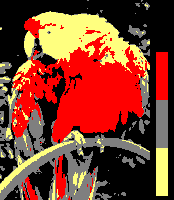
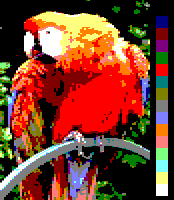

0 – Black (5) 1 – Dark blue (0,14) 2 – Blue (6) 3 – Dark red 4 – Dark magenta 5 – Violet 6 – Red (3) 7 – Magenta-red 8 – Magenta (7) 9 – Dark green 10 – Dark cyan (8) 11 – Cyan-blue (15) 12 – Dark yellow (9) 13 – Grey 14 – Light blue (10) 15 – Orange 16 – Pink (11, 15) 17 – Light magenta 18 – Green (12) 19 – Cyan-green 20 – Cyan (2) 21 – Yellow-green 22 – Light green (13) 23 – Light cyan 24 – Yellow (1, 14) 25 – Light yellow 26 – White (4)
The number in parentheses means the primary ink number for the Locomotive BASIC PEN, PAPER and INK statements (that is, "(1)" means ink #1 defaults to this color). Inks can also have a secondary color number, meaning they flash between two colors. By default, ink #14 alternates between colors 1 and 24 (blue and bright yellow) and ink #15 alternates between colors 11 and 16 (cyan-blue and pink). In addition, the paper defaults to ink #0 and the pen to ink #1, meaning yellow text on a dark blue background.
8-bit RGB palettes[]
The 8-bit RGB palettes (also known as 3-3-2 bit RGB) use 3 bits for each of the red and green color components, and 2 bits for the blue component, due to the lesser sensitivity of the common human eye to this primary color. This results in an 8×8×4 = 256-color palette as follows:
Red #000000 #240000 #490000 #6D0000 #920000 #B60000 #DB0000 #FF0000 Green #000000 #002400 #004900 #006D00 #009200 #00B600 #00DB00 #00FF00 Blue #000000 #000055 #0000AA #0000FF
Tiki 100[]
The Tiki 100 uses a 8-bit RGB palette (also described as 3-3-2 bit RGB), with 3 bits for each of the red and green color components, and 2 bits for the blue component. It supports 3 different resolutions with 256, 512 or 1024 by 256 pixels and 16, 4, or 2 colors respectively (freely selectable from the full 256 color palette).
Enterprise[]
The Enterprise computer has five graphics modes: 40- and 80-column text modes, Lo-Res and Hi-Res bit mapped graphics, and attribute graphics. Bit mapped graphics modes allow selection between displays of 2, 4,16 or 256 colors (from a 3-3-2 bit RGB palette), but horizontal resolution decreases as color depth increases.
Interlaced and non-interlaced modes are available. The maximum resolution is 640×512 pixels interlaced, or 640×256 pixels non-interlaced. These resolutions permit only a 2-colour display.
A 256-colour display has a maximum resolution of 80×256. The attribute graphics mode provides a 320×256 pixel resolution with 16 colors, selectable from a palette of 256.
Multiple pages can be displayed simultaneously on the screen, even if their graphics modes are different. Each page has its own palette, which allows more colors to be displayed onscreen simultaneously. The page height can be larger than the screen or the window it is displayed on. Each page is connected to a channel of the EXOS operating system, so it is possible to write on a hidden page.
MSX2[]
On the MSX2 screen mode 8 is a high-resolution 256×212-pixel mode with an 8-bit color depth, giving a palette of 256 colors (Fixed RGB mode of the Yamaha V9938 video chip).[8] From the MSB to LSB, there are three green bits, three red bits, and two blue bits. This mode uses half of the available colors overall, and can be considered a palette in its own right.
9-bit RGB palettes[]
The MSX2 series features a Yamaha V9938 video chip, which manages a 9-bit RGB palette (512 colors in Paletted RGB mode) and has some extended graphic modes. Although its graphical capabilities are similar, or even better than of those of 16-bit personal computers, MSX2 and MSX2+ (see below) are pure 8-bit machines.
Screen mode 6 is a 512×212-pixel mode with a 4-color palette chosen from the available 512 colors. Screen modes 5 and 7 are high-resolution 256×212-pixel and 512×212-pixel modes, respectively, with a 16-color palette chosen from the available 512 colors. Each pixel can be any of the 16 selected colors.
4-color screen mode 6 16-color screen mode 5 

15-bit RGB palettes[]
The MSX2+ series (released in 1988) features a Yamaha V9958 video chip which manages a 15-bit RGB palette internally encoded in YJK (up to 19,268 different colors from the 32,768 theoretically possible)[9] and has additional screen modes. Although its graphical capabilities are similar, or even better than of those of 16-bit personal computers, MSX2 (see above) and MSX2+ are pure 8-bit machines. YJK color encoding can be viewed as a lossy compression technique; in the RGB to YJK conversion, the average red and green levels are preserved, but blue is subsampled. As a result of every four pixels sharing a chroma value, in mode 12 it is not possible to have vertical lines of a single color. This is only possible in modes 10 and 11 due to the additional 16-color direct palette. This can be used to mix 16 indexed colors with a rich colorful background, in what can be considered a primitive video overlay technique.
Screen modes 10 & 11 – 12,499 YJK colors plus a 16-color palette. In this mode, the YJK technique encodes 16 levels of luminance into the four LSBs of each pixel and 64 levels of chroma, from −32 to +31, shared across every four consecutive pixels and stored in the three higher bits of the four pixels. If the fifth bit of the pixel is set, then the lower four bits of the pixel points to an index in the 16-color palette; otherwise, they specify the YJK luminance level of the pixel.
Screen mode 12 is similar to modes 10 and 11, but uses five bits to encode 32 levels of luminance for every pixel, thus it does not use an additional palette and, with YJK encoding, 19,268 different colors can be displayed simultaneously with 8-bit color depth.
Screen mode 10 & 11 Screen mode 12 

18-bit RGB palettes[]
hideThis section has multiple issues. Please help or discuss these issues on the talk page. (Learn how and when to remove these template messages)
|
Fujitsu's FM-77 AV 40, released in 1986, uses an 18-bit RGB palette. Any 64,000 out of 262,144 colors can be displayed simultaneously at the 320×200 resolution, or 8 out of 262,144 colors at the 640×400 resolution.
Composite video palettes[]
This section covers systems that generate color directly as composite video, closely related with display on analog CRT TVs. Many of the colors are non-standard and outside of RGB gamut, and would only display properly on NTSC hardware. Due to the varying ways of converting a composite signal to sRGB (the standard for internet images), images in this section will be inconsistent with each other in color until further notice.
Atari 400/800/XL/XE[]
The early Atari 400 and 800 computers use a palette of 128 colors (a bit similar to the one used on the Atari 2600 console, and the Commodore 16 and Plus/4), using 4 bits for chrominance, and 3 for luminance. Screen modes may vary from 320×192 (384x240 with overscan) to 40×24, using 2 or 4 simultaneous colors, or 80×192 (96x240 with overscan) using 16 colors. After 2 years (late 1981) the CTIA graphics chip was replaced with the GTIA chip thus increasing the palette to 256 colors (CTIA and GTIA).
The ANTIC chip in the Atari 8-bit family computers (400, 800, XL and XE models) has an instruction set to run programs (called display list) which permits many more colors on the screen at once. There are a number of possible software-driven graphics modes.
CTIA palette[]
luminance hue
|
0 | 2 | 4 | 6 | 8 | 10 | 12 | 14 |
|---|---|---|---|---|---|---|---|---|
| 0 | ||||||||
| 1 | ||||||||
| 2 | ||||||||
| 3 | ||||||||
| 4 | ||||||||
| 5 | ||||||||
| 6 | ||||||||
| 7 | ||||||||
| 8 | ||||||||
| 9 | ||||||||
| 10 | ||||||||
| 11 | ||||||||
| 12 | ||||||||
| 13 | ||||||||
| 14 | ||||||||
| 15 |
GTIA palette[]
luminance hue
|
0 | 1 | 2 | 3 | 4 | 5 | 6 | 7 | 8 | 9 | 10 | 11 | 12 | 13 | 14 | 15 |
|---|---|---|---|---|---|---|---|---|---|---|---|---|---|---|---|---|
| 0 | ||||||||||||||||
| 1 | ||||||||||||||||
| 2 | ||||||||||||||||
| 3 | ||||||||||||||||
| 4 | ||||||||||||||||
| 5 | ||||||||||||||||
| 6 | ||||||||||||||||
| 7 | ||||||||||||||||
| 8 | ||||||||||||||||
| 9 | ||||||||||||||||
| 10 | ||||||||||||||||
| 11 | ||||||||||||||||
| 12 | ||||||||||||||||
| 13 | ||||||||||||||||
| 14 | ||||||||||||||||
| 15 |
Apple II series[]
The Apple II series features a 16-color composite video palette, based on the YIQ color space used by the NTSC color TV system.[10][11]
The Apple II features "low-res" and "hi-res" modes. The 40x48 pixel lo-res mode allowed 15 different colors plus a duplicate gray(**).[12] * The majority of Apple graphic applications used the hi-res mode, which had 280×192 pixels (effectively 140x192 on a color monitor). The hi-res mode allowed six colors: black, white, blue, orange, green and purple.
Low-res mode palette
Number — name Y I Q Number — name Y I Q 0 — black* 0 0 0 8 — brown*** 0.25 0.5 -0.5 1 — red 0.25 0.5 0.5 9 — orange* 0.5 1 0 2 — dark blue 0.25 -0.5 0.5 10 — gray** 0.5 0 0 3 — purple* 0.5 0 1 11 — pink 0.75 0.5 0.5 4 — dark green 0.25 -0.5 -0.5 12 — bright green* 0.5 0 -1 5 — gray** 0.5 0 0 13 — yellow 0.75 0.5 -0.5 6 — blue-cyan* 0.5 -1 0 14 — cyan 0.75 -0.5 0.5 7 — light blue*** 0.75 -0.5 0.5 15 — white* 1 0 0
- Note: Colors with italic text and marked with three asterisks (***) are out of the RGB gamut.
High-res mode palette
High bit Pixel pair Number — Name Y I Q 0 00 0 — black 0 0 0 0 01 1 — purple 0.5 1 1 0 10 2 — green 0.5 −1 −1 0 11 3 — white 1 0 0 1 00 4 — black 0 0 0 1 01 5 — blue 0.5 1 −1 1 10 6 — orange 0.5 −1 1 1 11 7 — white 1 0 0
Systems based on MOS Technology chips[]
For all the following computers from Commodore, the U and V coordinates for the composite video colors are always the cosine and the sine, respectively, of angles multiple of 22.5 degrees (i.e. a quarter of 90°), as the engineers were inspired by the NTSC color wheel, a radial way to figure out the U and V coordinates of points equidistant from the center of the chroma plane, the gray. Consumers in Europe (which uses PAL) considered the Commodore colors to be more "washed out" and less vivid than those provided by computers such as the ZX Spectrum.[13][14][15]
Commodore VIC-20[]
The Commodore VIC-20 features an MOS Technology VIC chip which produces a 16-color composite video palette.[16] The palette lacks any intermediate shade of gray, and it has only 5 levels of luminance.
The VIC-20 lacks any true graphic mode, but a 22×11 text mode with 200 definable characters of 8×16 bits each arranged as a matrix of 20×10 characters is usually used instead, giving a 3:2(NTSC)/5:3(PAL) pixel aspect ratio, 160×160 pixels, 8-color "high-res mode" or a 3:1(NTSC)/10:3(PAL) pixel aspect ratio, 80×160 pixels, 10-color "multicolor mode".
VIC-20 palette 


In the 8-color high-res mode, every 8×8 pixels can have the background color (shared for the entire screen) or a free foreground color, both selectable among the first eight colors of the palette. In the 10-color multicolor mode, a single pixel of every 4×8 block (a character cell) may have any of four colors: the background color, the auxiliary color (both shared for the entire screen and selectable among the entire palette), the same color as the overscan border (also a shared color) or a free foreground color, both selectable among the first eight colors of the palette.
Simulated images
Multicolor mode High-res mode 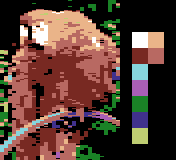
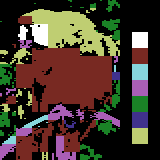
On some models of the system, there are nine levels of luminance:
Number — name Y U V Number — name Y U V 0 — black 0 0 0 8 — orange 0.375 −0.7071068 0.7071068 1 — white 1 0 0 9 — light orange 0.625 −0.7071068 0.7071068 2 — red 0.3125 −0.3826834 0.9238795 10 — light red 0.5 −0.3826834 0.9238795 3 — cyan 0.6875 0.3826834 −0.9238795 11 — light cyan 0.75 0.3826834 −0.9238795 4 — purple 0.3125 0.7071068 0.7071068 12 — light purple 0.5 0.7071068 0.7071068 5 — green 0.5 −0.7071068 −0.7071068 13 — light green 0.75 −0.7071068 −0.7071068 6 — blue 0.25 1 0 14 — light blue 0.5 1 0 7 — yellow 0.6875 −1 0 15 — light yellow 1 −1 0
But on other models, there are only five levels of luminance:
Number — name Y U V Number — name Y U V 0 — black 0 0 0 8 — orange 0.5 −0.7071068 0.7071068 1 — white 1 0 0 9 — light orange 0.75 −0.7071068 0.7071068 2 — red 0.25 −0.3826834 0.9238795 10 — light red 0.5 −0.3826834 0.9238795 3 — cyan 0.75 0.3826834 −0.9238795 11 — light cyan 1 0.3826834 −0.9238795 4 — purple 0.5 0.7071068 0.7071068 12 — light purple 0.75 0.7071068 0.7071068 5 — green 0.5 −0.7071068 −0.7071068 13 — light green 0.75 −0.7071068 −0.7071068 6 — blue 0.25 1 0 14 — light blue 0.5 1 0 7 — yellow 0.75 −1 0 15 — light yellow 1 −1 0
Commodore 64[]
The MOS Technology VIC-II is used in the Commodore 64 (and Commodore 128 in 40-column mode), and features a 16-color YPbPr composite video palette.[17] This palette is largely based on that of the VIC, but it substitutes three colors by three levels of gray. When displayed over an analog NTSC composite video output, the actual resulting colors are more vivid.
Sample image Color test chart Color palette C64 palette on NTSC (Sony CXA2025 decoder matrix) 
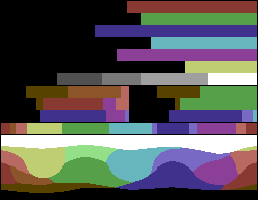

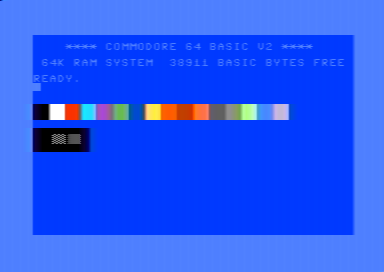 [18]
[18]
The Commodore 64 has two graphic modes: Multicolor and High Resolution.
In the Multicolor 160×200, 16-color mode, every cell of 4×8, 2:1 aspect ratio pixels can have one of four colors: one shared with the entire screen, the two background and foreground colors of the corresponding text mode character, and one more color also stored in the color RAM area, all of them freely selectable among the entire palette.
In the High Resolution 320×200, 16-color mode, every cell of 8×8 pixels can have one of the two background and foreground colors of the correspondent text mode character, both freely selectable among the entire palette.
Simulated images
16-color multicolor mode 16-color High-res mode 

On most models of the Commodore 64, there are nine levels of luminance:
Number — name Y U V Number — name Y U V 0 — black 0 0 0 8 — orange 0.375 −0.7071068 0.7071068 1 — white 1 0 0 9 — brown 0.25 −0.9238795 0.3826834 2 — red 0.3125 −0.3826834 0.9238795 10 — light red 0.5 −0.3826834 0.9238795 3 — cyan 0.625 0.3826834 −0.9238795 11 — dark grey 0.3125 0 0 4 — purple 0.375 0.7071068 0.7071068 12 — grey 0.46875 0 0 5 — green 0.5 −0.7071068 −0.7071068 13 — light green 0.75 −0.7071068 −0.7071068 6 — blue 0.25 1 0 14 — light blue 0.46875 1 0 7 — yellow 0.75 −1 0 15 — light grey 0.625 0 0
Commodore 16 and Plus/4[]
The MOS Technology TED was used in the Commodore 16 and Commodore Plus/4. It has a palette of 121 composite video colors[19] consisting of sixteen hues (including black and white) at eight luminance levels. Black is the same color at every luminance level, so there are not 128 different colors. On the Commodore Plus/4, twelve colors formed a "default" palette of sorts accessible through keyboard shortcuts;[20] these colors are underlined in the table below (RGB converted colors at a saturation level of 34%).
The Commodore 16 and Commodore Plus/4 have two graphic modes very similar to those of the Commodore 64: Multicolor and High Resolution.
In the Multicolor 160×200, 121-color mode, every cell of 4×8, 2:1 aspect ratio pixels can have one of four colors: two shared with the entire screen and the two background and foreground colors of the correspondent text mode character, all of them freely selectable among the entire 121-color palette (hue 0 to 15 and luminance 0 to 7 are set individually for any of them).
In the High Resolution 320×200, 121-color mode, every cell of 8×8 pixels can have one of the two background and foreground colors of the corresponding text mode character, both freely selectable among the entire 121-color palette (again setting both the hue and the luminance).
Simulated images
121-color Multicolor mode 121-color High-res mode 
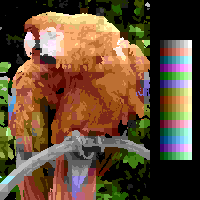
luma # 0 1 2 3 4 5 6 7 Y 0.125 0.25 0.375 0.5 0.625 0.75 0.875 1 hue # U V . . . . . . . . 0 — black 0 0 0,0 0,1 0,2 0,3 0,4 0,5 0,6 0,7 1 — white 0 0 1,0 1,1 1,2 1,3 1,4 1,5 1,6 1,7 2 — red −0.3826834 0.9238795 2,0 2,1 2,2 2,3 2,4 2,5 2,6* 2,7* 3 — cyan 0.3826834 −0.9238795 3,0* 3,1 3,2 3,3 3,4 3,5 3,6 3,7* 4 — purple 0.7071068 0.7071068 4,0* 4,1 4,2 4,3 4,4 4,5 4,6* 4,7* 5 — green −0.7071068 −0.7071068 5,0* 5,1 5,2 5,3 5,4 5,5 5,6* 5,7* 6 — blue 1 0 6,0 6,1 6,2 6,3 6,4 6,5* 6,6* 6,7* 7 — yellow −1 0 7,0* 7,1* 7,2 7,3 7,4 7,5 7,6 7,7* 8 — orange −0.7071068 0.7071068 8,0* 8,1 8,2 8,3 8,4 8,5 8,6* 8,7* 9 — brown −0.9238795 0.3826834 9,0* 9,1* 9,2 9,3 9,4 9,5 9,6 9,7* 10 — yellow-green −0.9238795 −0.3826834 10,0* 10,1* 10,2 10,3 10,4 10,5 10,6 10,7* 11 — pink 0 1 11,0 11,1 11,2 11,3 11,4 11,5 11,6* 11,7* 12 — blue-green 0 −1 12,0* 12,1 12,2 12,3 12,4 12,5 12,6 12,7* 13 — light blue 0.7071068 −0.7071068 13,0* 13,1 13,2 13,3 13,4 13,5 13,6* 13,7* 14 — dark blue 0.9238795 0.3826834 14,0 14,1 14,2 14,3 14,4 14,5* 14,6* 14,7* 15 — light green −0.3826834 −0.9238795 15,0* 15,1 15,2 15,3 15,4 15,5 15,6* 15,7*
Notes:
Systems based on the Texas Instruments TMS9918 chip[]
The TMS9918 is a Video Display Controller (VDC) manufactured by Texas Instruments and introduced in 1979. The TMS9918 and its variants were used in the Memotech MTX, MSX, Sord M5, Tatung Einstein and Tomy Tutor.
The TMS9918 chip which uses a proprietary 15-color composite color encoded palette[21] plus a transparent color, intended to be used by the hardware sprites and simple video overlay. When used as an ordinary background color, it is rendered using the same color as the screen border.
Number — name Y U V Number — name Y U V 0 — transparent N/A N/A N/A 8 — medium red 0.53 −0.377 0.868 1 — black 0 0 0 9 — (light red) 0.67 −0.377 0.868 2 — medium green 0.53 −0.509 −0.755 10 — dark yellow 0.73 −0.755 0.189 3 — light green 0.67 −0.377 −0.566 11 — light yellow 0.80 −0.566 0.189 4 — dark blue 0.40 1 −0.132 12 — dark green 0.47 −0.453 −0.642 5 — light blue 0.53 0.868 −0.075 13 — magenta 0.53 0.377 0.491 6 — dark red 0.47 −0.321 0.679 14 — gray 0.80 0 0 7 — cyan 0.73 0.434 −0.887 15 — white 1 0 0
- Note: The colors inside the parentheses are out of RGB gamut.
MSX[]
The MSX series has two graphic modes. The MSX BASIC Screen 3 mode is a low-resolution mode with 15 colors, in which every pixel can be any of the 15 available colors. Screen mode 2 is a 256×192 high-resolution mode with 15 colors, in which each of every eight consecutive pixels can only use 2 colors.
15-color screen mode 3 15-color screen mode 2 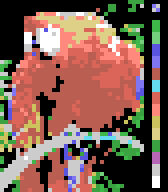

Systems based on the Motorola 6847 chip[]
The MC6847 is a video display generator (VDG) first introduced by Motorola and used in the TRS-80 Color Computer, Dragon 32/64, Laser 200, TRS-80 MC-10, NEC PC-6000 series, Acorn Atom, and the APF Imagination Machine, among others.
Color as generated by the Motorola 6847 video hardware chip:
| green | yellow | blue | red | buff | cyan | magenta | orange | black | dark green | dark orange |
TRS-80 Color Computer[]
The TRS-80 Color Computer is capable of displaying text and graphics contained within a roughly square display matrix 256 pixels wide by 192 lines high. The hardware palette has 9 colors: black, green, yellow, blue, red, buff (almost-but-not-quite white), cyan, magenta, and orange.[22]
All colors are available in text modes. In color modes (64×64, 128×64, 128×96, and 128×192) two four color palettes are available: a green border with the colors green, yellow, red, and blue; a white border with the colors white, cyan, magenta, and orange.
Display modes
Text Mode (9 colors) Color mode (4 colors) Color mode (alternate palette) 


NEC PC-6000 series[]
Similar to other computers using the same video chip, the NEC PC-6000 series had four screen modes:
- 32x16 characters with 4 colors
- 64x48 pixel graphics with 9 colors
- 128x192 graphics with 4 colors
- 256x192 graphics with 2 colors (green, white)
Other palettes[]
Tandy Color Computer 3[]
The Tandy Color Computer 3 could display all of the modes of the Tandy Color Computer 1 and 2, except the Semigraphics modes, plus resolutions of 160, 256, 320, or 640 pixels wide by 192 to 225 lines from a palette of 64 colors. The 320 mode allowed 16 simultaneous colors, while the 640 mode allowed 4.
SAM Coupé[]
The 128 color master palette used by the SAM Coupé is produced via a unique method — it effectively contains 2 groups of 64 "RGB" colors of mildly different intensity, and ultimately derived from a 512 color space.[23] The closest equivalent in more popular and well-known machines would be the Commodore-Amiga's 64-color "Extra Half-Brite" mode (with 32 explicitly set colors using 5 bitplanes, which are displayed with full or half brightness depending on the bit setting of a 6th plane).
Two bits are used for each of Red, Green and Blue and give a similar result to a normal 6-bit RGB palette (as seen with the IBM EGA or Sega Master System); the seventh bit encodes for "brightness", which has a similar but more subtle effect to the Spectrum, increasing the output of all three channels by half the intensity of the lower bits of the main six (in this way, it does make a genuine 128 colors — rather than 127 colors with "two blacks" and only a 7-level grayscale). The layout of the byte that encodes each color is complicated and appears like a Spectrum color nybble transferred to a full byte's width, and an extra RGB bit-triplet then prefixed to it, with the MSB left unused.
SAM Coupé color palette and bitmask 0x00 0x01 0x02 0x03 0x04 0x05 0x06 0x07 0x08 0x09 0x0A 0x0B 0x0C 0x0D 0x0E 0x0F 0x10 0x11 0x12 0x13 0x14 0x15 0x16 0x17 0x18 0x19 0x1A 0x1B 0x1C 0x1D 0x1E 0x1F 0x20 0x21 0x22 0x23 0x24 0x25 0x26 0x27 0x28 0x29 0x2A 0x2B 0x2C 0x2D 0x2E 0x2F 0x30 0x31 0x32 0x33 0x34 0x35 0x36 0x37 0x38 0x39 0x3A 0x3B 0x3C 0x3D 0x3E 0x3F 0x40 0x41 0x42 0x43 0x44 0x45 0x46 0x47 0x48 0x49 0x4A 0x4B 0x4C 0x4D 0x4E 0x4F 0x50 0x51 0x52 0x53 0x54 0x55 0x56 0x57 0x58 0x59 0x5A 0x5B 0x5C 0x5D 0x5E 0x5F 0x60 0x61 0x62 0x63 0x64 0x65 0x66 0x67 0x68 0x69 0x6A 0x6B 0x6C 0x6D 0x6E 0x6F 0x70 0x71 0x72 0x73 0x74 0x75 0x76 0x77 0x78 0x79 0x7A 0x7B 0x7C 0x7D 0x7E 0x7F 0x01 (low blue) 0x02 (low red) 0x04 (low green) 0x08 (brightness) 0x10 (high blue) 0x20 (high red) 0x40 (high green)
Side-by-side comparison[]
This section needs expansion. You can help by . (March 2019) |
Since there are many 8-bit computers to compare, a comparison table has been compiled to make comparing the systems easier.
| Computer(s) | Picture sample(s) | Entire palette(s) | Number of colors on screen | Resolution(s) | |||
|---|---|---|---|---|---|---|---|
| Apple II | Hi-res:
Lo-res:
|
Hi-res:
Lo-res: |
6 (high resolution mode), or 16 (low resolution mode) | 280x192 in high resolution or 40x48 in low resolution | |||
| Atari 8-bit line | Mode 15 (with color interrupts and MCS):
|

|
9 colors per scanline on mode 15 via masking the 4 sprites for colors, and interrupts. | Ranges from 320x192, with 1 color, to 80x192 with 9 colors. | |||
| Mattel Aquarius | 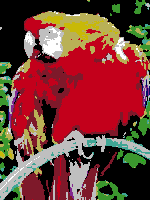
|

|
16 colors | 40x24 characters | |||
| BBC Micro |
|
|
Ranges from 2 to 8 colors | Ranges from 640x256 to 160x256 | |||
| Commodore 64 | High res mode:
Multicolor mode:
|

|
All 16 colors can be present in one screen. However, 4 can be present in one 4 x 8 cell in multicolor mode, and three of those colors must be shared. 2 colors can be present in every 8 x 8 cell in high resolution mode. | 320 x 200 in high resolution mode
160 x 200 in multicolor mode | |||
| CGA | 16 color mode:
4 color modes:
2 color mode:
|

|
320×200 graphics mode is restricted to fixed palettes containing only four colors; 640×200 graphic mode is only two colors | 160 x 200, 320 x 200, 640 x 200 |
See also[]
- List of color palettes
- List of monochrome and RGB color formats
- List of software palettes
- List of video game console palettes
- List of 16-bit computer hardware palettes
- Palette (computing)
- Indexed color
- Color Lookup Table
- Color depth
References[]
- ^ Richard Wilton, Programmer's Guide to PC & PS/2 VIDEO SYSTEMS, 1987, Microsoft Press.
- ^ http://dcmoto.free.fr/documentation/schemas/mo5v3.png
- ^ http://dcmoto.free.fr/documentation/guidemo5/index.html
- ^ http://dcmoto.free.fr/documentation/thomson.html
- ^ https://www.old-computers.com/museum/software/thomson_mo5nr_boot_3.jpg
- ^ http://atariage.com/forums/uploads/monthly_07_2014/post-3819-0-00736800-1405189983.jpg
- ^ "The Amstrad CPC Firmware Guide"
- ^ Bits M1-M5 of VDP register 0 and 1: Video Screen modes, Screen 8 from "Portar MSX Tech Doc" Archived 2007-11-30 at the Wayback Machine
- ^ "The MSX Plaza". msx-plaza.eu.
- ^ "The Laboratorium : Why Did the Apple II Have Six Colors?". laboratorium.net.
- ^ http://www.downloads.reactivemicro.com/Public/Users/Grant_Stockley/Apple2MoreColorsBYTEJun1979.pdf
- ^ http://apple-2.com/pdf/bbfront.png
- ^ "Spectrum vs C64" match, Italy, 1985 "The blue was simply stunning. The red made the room warm. The magenta was like an exotic icecream. The green was something like freshly rained grass. The cyan was like the ocean's water. The yellow seemed got off from a fluorescent pen. And the white was clean and soft ... The C64 screen first became black (but not too much), then became white (an exaggerated white), then orange, then something like bluish, then a vaguely magenta, then a poor water-greenish, then a bright bluish, then a faded yellow, then a weird brown, and then a light gray... well, all "pastel-like" colours"
- ^ ZX Spectrum vs Commodore 64 – the playground argument settled "you will remember the playground taunts regarding washed out colours, peeks and pokes and the relative lack of software in your local WH Smith"
- ^ ZX Spectrum vs Commodore 64 "the C64 had muddy colours...but whack up the colour saturation of your TV and most of that was alleviated"
- ^ "The 6561 VIC chip". Archived from the original on 2010-04-01. 090420 fpgaarcade.com
- ^ Philip 'Pepto' Timmermann (12 March 2001). "All you ever wanted to know about the colors of the commodore 64". pepto.de.
- ^ "C64 Emulator Palette from my NTSC 1702 - Page 2 - Commodore 64 (C64) Forum". lemon64.com.
- ^ Commodore Hacking #12 : Talking to TED Archived 2009-01-05 at the Wayback Machine
- ^ Color codes Archived 2007-09-27 at the Wayback Machine
- ^ VDP Registers 00h-07h: Basic MSX1/MSX2 Video Registers from "Portar MSX Tech Doc" Archived 2007-11-30 at the Wayback Machine
- ^ https://colorcomputerarchive.com/repo/Documents/Manuals/Hardware/Color%20Computer%20Operation%20Manual%20(Tandy).pdf
- ^ Cooke, Simon; et al. (1994). "The Graphics Hardware" (PDF). The Unofficial SAM Coupé Technical Manual (sampler edition). Σntropy. pp. 16–20. Retrieved 5 February 2013.
- Computer graphics
- Color depths
- Computing output devices





